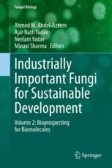Search
Search Results
-
Surfactants: physicochemical interactions with biological macromolecules
Macromolecules are essential cellular components in biological systems responsible for performing a large number of functions that are necessary for...

-
Exploring the transportome of the biosurfactant producing yeast Starmerella bombicola
Starmerella bombicola is a non-conventional yeast mainly known for its capacity to produce high amounts of the glycolipids ‘sophorolipids’. Although...

-
Anticarcinogenic Potential of Probiotic, Postbiotic Metabolites and Paraprobiotics on Human Cancer Cells
The performance of probiotic bacteria and their metabolites in the control and treatment of various cancers has been shown by a number of clinical...
-
Eminence of Microbial Products in Cosmetic Industry
AbstractCosmetology is the develo** branch of science, having direct impact on the society. The cosmetic sector is interested in finding novel...

-
Recent Trends in the Utilization of Biosurfactant for the Treatment of Textile Waste and Industrial Effluents
The impeded advent of urbanization and the high rate of rapid growth in the level of industrialization have affected negatively several biological...
-
Biosurfactants, Bioemulsifiers, and Biopolymers from Thermophilic Microorganisms
Secondary metabolites are produced by bacteria, fungi, and plants. They are not directly linked with the normal growth or development of an organism...
-
Screening of Actinobacteria for Biological Activities
Members of the phylum actinobacteria have the tremendous potential to produce various bioactive metabolites and also exhibit different biological...
-
GC–MS based profiling of alkanes in the filamentous yeast Hyphozyma roseoniger (Moesziomyces antarcticus)
ObjectivesHyphozyma roseoniger, a filamentous yeast, is used as a biocatalyst in the bio-transformation of terpenoids; however, the microorganism’s...

-
Bioprocessing with Cashew Apple and Its By-Products
Global industrialization has led to an enhanced production and use of enzymes and value-added products in various industrial sectors. As the demand...
-
Fungal Secondary Metabolites: Current Research, Commercial Aspects, and Applications
Secondary metabolites are believed to have no function in the lifecycle of producer cells, unlike primary metabolites. They are chemically...
-
Extreme environments: a source of biosurfactants for biotechnological applications
The surfactant industry moves billions of dollars a year and consists of chemically synthesized molecules usually derived from petroleum. Surfactant...

-
Biodiversity of Biosurfactants and Roles in Enhancing the (Bio)availability of Hydrophobic Substrates
This chapter focusses on the biodiversity of microbial biosurfactants and the organisms that produce them. Specific attention is given to the low...
-
Advances on research in the use of agro-industrial waste in biosurfactant production
Biosurfactants are amphiphilic molecules produced by a variety of microorganisms, including bacteria, yeast and filamentous fungi. Unlike chemically...

-
Microbial Biosurfactants: Future Active Food Ingredients
Microbial surfactants are a structurally diverse group of surface-active molecules produced by microorganisms. The rising environmental apprehension...
-
Production of Trehalolipid Biosurfactants by Rhodococcus
Members of the genus Rhodococcus produce biosurfactants in response to the presence of liquid hydrocarbons in the growth medium. These biosurfactants...
-
Microbial Products and Biotechnological Applications Thereof: Proteins, Enzymes, Secondary Metabolites, and Valuable Chemicals
Microbial species are among prominent producers of useful natural products, which are a very diverse collection of molecules. These natural products...
-
Psychrophilic lifestyles: mechanisms of adaptation and biotechnological tools
Cold-adapted microorganisms inhabiting permanently low-temperature environments were initially just a biological curiosity but have emerged as rich...
-
New Insights of Ustilago maydis as Yeast Model for Genetic and Biotechnological Research: A Review
The basidiomycete Ustilago maydis is a biotrophic organism responsible for corn smut disease. In recent years, it has become one of the most...

-
Current status in biotechnological production and applications of glycolipid biosurfactants
Biosurfactants are natural compounds with surface activity and emulsifying properties produced by several types of microorganisms and have been...

-
Biotechnological production of value-added compounds by ustilaginomycetous yeasts
The use of yeasts in bioprocesses can be considered one of the most relevant strategies in industrial biotechnology, and their potential is...

